Business Finance Report: Root and Cook Ltd. Financial Analysis
VerifiedAdded on 2020/06/06
|10
|3010
|61
Report
AI Summary
This report provides a comprehensive overview of key business finance concepts, focusing on the financial management of Root and Cook Ltd. It begins by differentiating between profit and cash flow, emphasizing the importance of managing both for operational success. The report then delves into working capital, explaining the roles of receivables, inventory, and payables, and how changes in these areas impact cash flow. It examines how management decisions affect financial results, particularly concerning the case study of Root and Cook Ltd., and offers recommendations for improving cash flow through effective working capital management. Furthermore, the report covers capital budgeting, outlining its purpose, key steps, and investment appraisal methods such as payback period, net present value, and internal rate of return. Finally, it explores alternative investment options, including private equity, direct investment, venture capital, and hedge funds, providing insights into diversification strategies for financial portfolios. The report concludes with recommendations for the company's projects, offering a practical approach to financial decision-making and investment analysis.

BUSINESS FINANCE
Paraphrase This Document
Need a fresh take? Get an instant paraphrase of this document with our AI Paraphraser
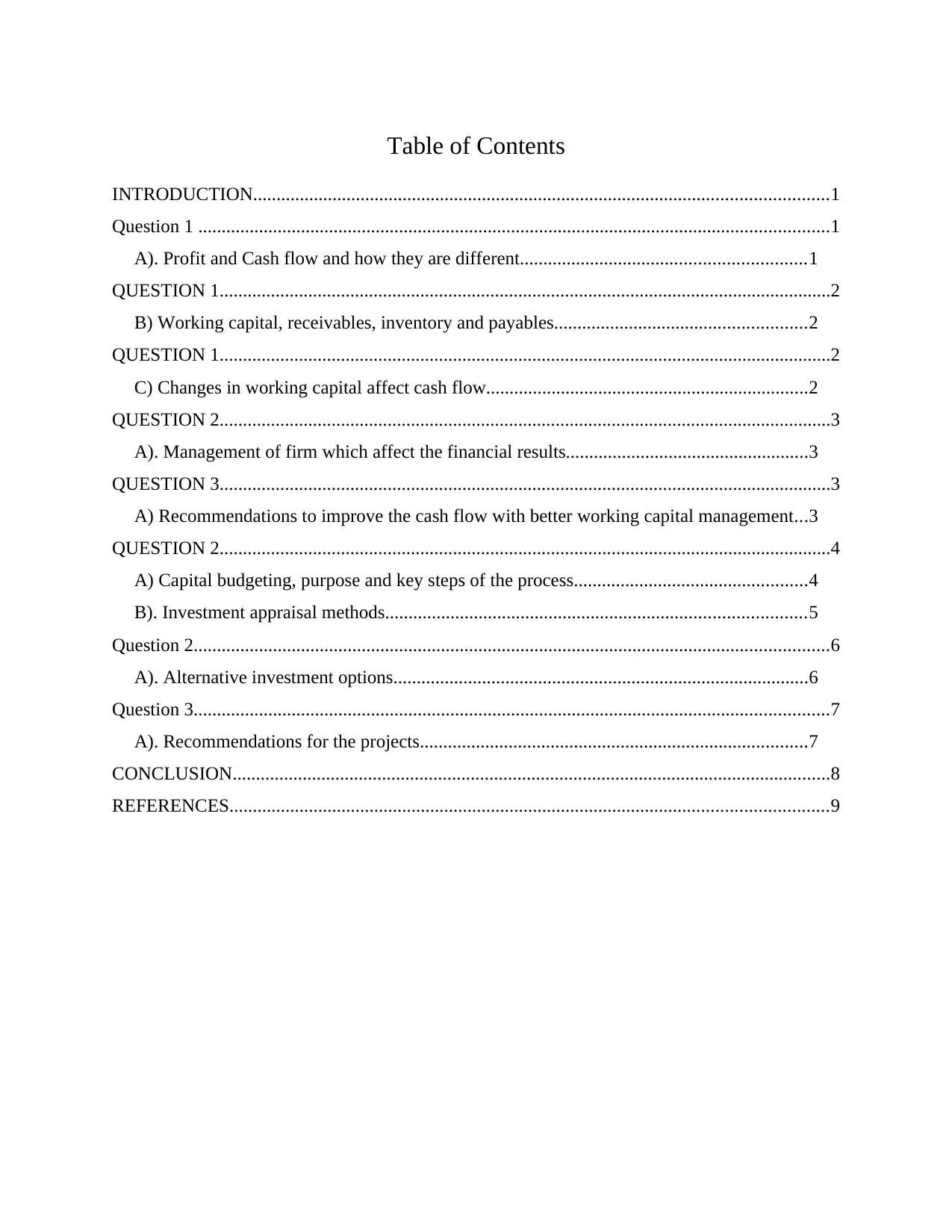
Table of Contents
INTRODUCTION...........................................................................................................................1
Question 1 .......................................................................................................................................1
A). Profit and Cash flow and how they are different.............................................................1
QUESTION 1...................................................................................................................................2
B) Working capital, receivables, inventory and payables......................................................2
QUESTION 1...................................................................................................................................2
C) Changes in working capital affect cash flow.....................................................................2
QUESTION 2...................................................................................................................................3
A). Management of firm which affect the financial results....................................................3
QUESTION 3...................................................................................................................................3
A) Recommendations to improve the cash flow with better working capital management...3
QUESTION 2...................................................................................................................................4
A) Capital budgeting, purpose and key steps of the process..................................................4
B). Investment appraisal methods..........................................................................................5
Question 2........................................................................................................................................6
A). Alternative investment options.........................................................................................6
Question 3........................................................................................................................................7
A). Recommendations for the projects...................................................................................7
CONCLUSION................................................................................................................................8
REFERENCES................................................................................................................................9
INTRODUCTION...........................................................................................................................1
Question 1 .......................................................................................................................................1
A). Profit and Cash flow and how they are different.............................................................1
QUESTION 1...................................................................................................................................2
B) Working capital, receivables, inventory and payables......................................................2
QUESTION 1...................................................................................................................................2
C) Changes in working capital affect cash flow.....................................................................2
QUESTION 2...................................................................................................................................3
A). Management of firm which affect the financial results....................................................3
QUESTION 3...................................................................................................................................3
A) Recommendations to improve the cash flow with better working capital management...3
QUESTION 2...................................................................................................................................4
A) Capital budgeting, purpose and key steps of the process..................................................4
B). Investment appraisal methods..........................................................................................5
Question 2........................................................................................................................................6
A). Alternative investment options.........................................................................................6
Question 3........................................................................................................................................7
A). Recommendations for the projects...................................................................................7
CONCLUSION................................................................................................................................8
REFERENCES................................................................................................................................9
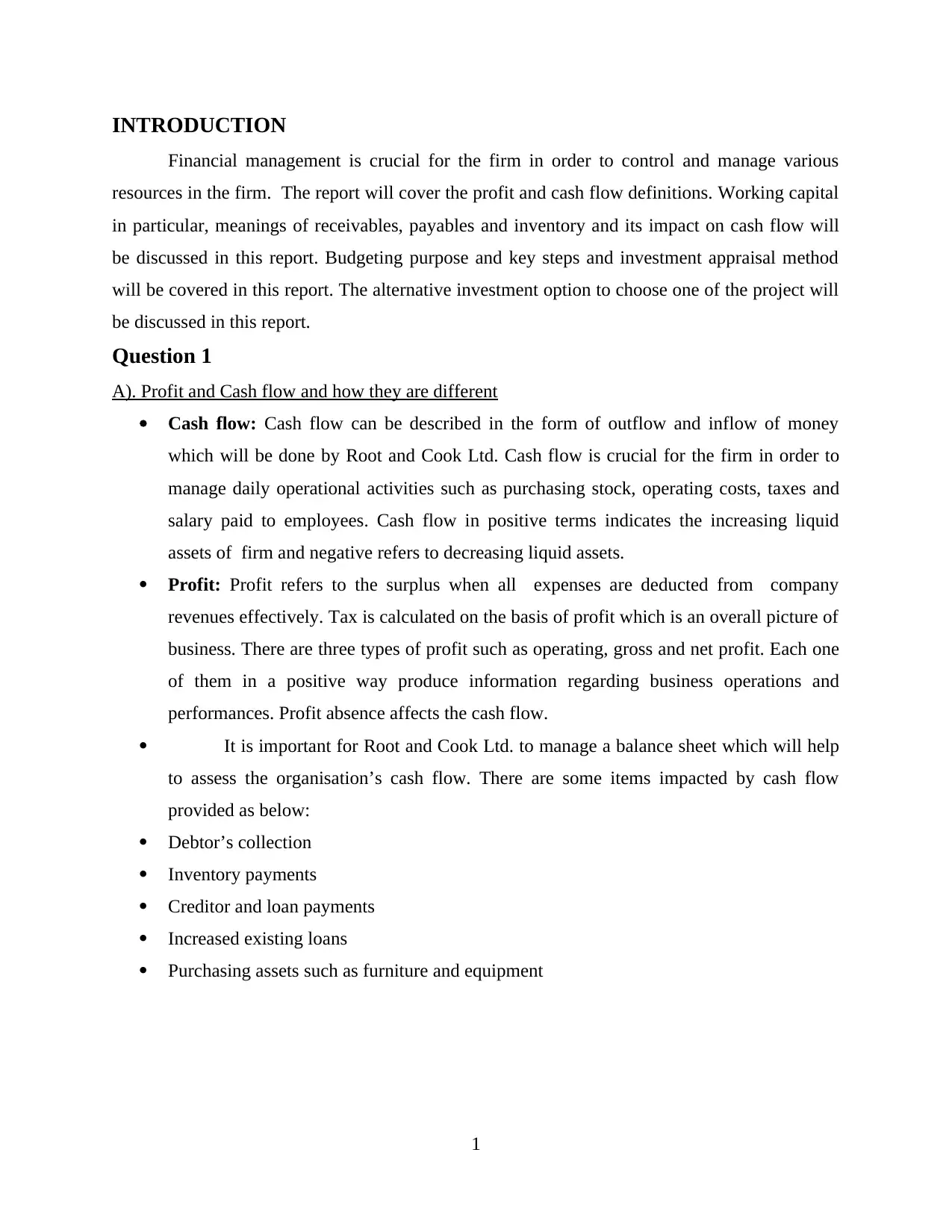
INTRODUCTION
Financial management is crucial for the firm in order to control and manage various
resources in the firm. The report will cover the profit and cash flow definitions. Working capital
in particular, meanings of receivables, payables and inventory and its impact on cash flow will
be discussed in this report. Budgeting purpose and key steps and investment appraisal method
will be covered in this report. The alternative investment option to choose one of the project will
be discussed in this report.
Question 1
A). Profit and Cash flow and how they are different
Cash flow: Cash flow can be described in the form of outflow and inflow of money
which will be done by Root and Cook Ltd. Cash flow is crucial for the firm in order to
manage daily operational activities such as purchasing stock, operating costs, taxes and
salary paid to employees. Cash flow in positive terms indicates the increasing liquid
assets of firm and negative refers to decreasing liquid assets.
Profit: Profit refers to the surplus when all expenses are deducted from company
revenues effectively. Tax is calculated on the basis of profit which is an overall picture of
business. There are three types of profit such as operating, gross and net profit. Each one
of them in a positive way produce information regarding business operations and
performances. Profit absence affects the cash flow.
It is important for Root and Cook Ltd. to manage a balance sheet which will help
to assess the organisation’s cash flow. There are some items impacted by cash flow
provided as below:
Debtor’s collection
Inventory payments
Creditor and loan payments
Increased existing loans
Purchasing assets such as furniture and equipment
1
Financial management is crucial for the firm in order to control and manage various
resources in the firm. The report will cover the profit and cash flow definitions. Working capital
in particular, meanings of receivables, payables and inventory and its impact on cash flow will
be discussed in this report. Budgeting purpose and key steps and investment appraisal method
will be covered in this report. The alternative investment option to choose one of the project will
be discussed in this report.
Question 1
A). Profit and Cash flow and how they are different
Cash flow: Cash flow can be described in the form of outflow and inflow of money
which will be done by Root and Cook Ltd. Cash flow is crucial for the firm in order to
manage daily operational activities such as purchasing stock, operating costs, taxes and
salary paid to employees. Cash flow in positive terms indicates the increasing liquid
assets of firm and negative refers to decreasing liquid assets.
Profit: Profit refers to the surplus when all expenses are deducted from company
revenues effectively. Tax is calculated on the basis of profit which is an overall picture of
business. There are three types of profit such as operating, gross and net profit. Each one
of them in a positive way produce information regarding business operations and
performances. Profit absence affects the cash flow.
It is important for Root and Cook Ltd. to manage a balance sheet which will help
to assess the organisation’s cash flow. There are some items impacted by cash flow
provided as below:
Debtor’s collection
Inventory payments
Creditor and loan payments
Increased existing loans
Purchasing assets such as furniture and equipment
1
⊘ This is a preview!⊘
Do you want full access?
Subscribe today to unlock all pages.

Trusted by 1+ million students worldwide
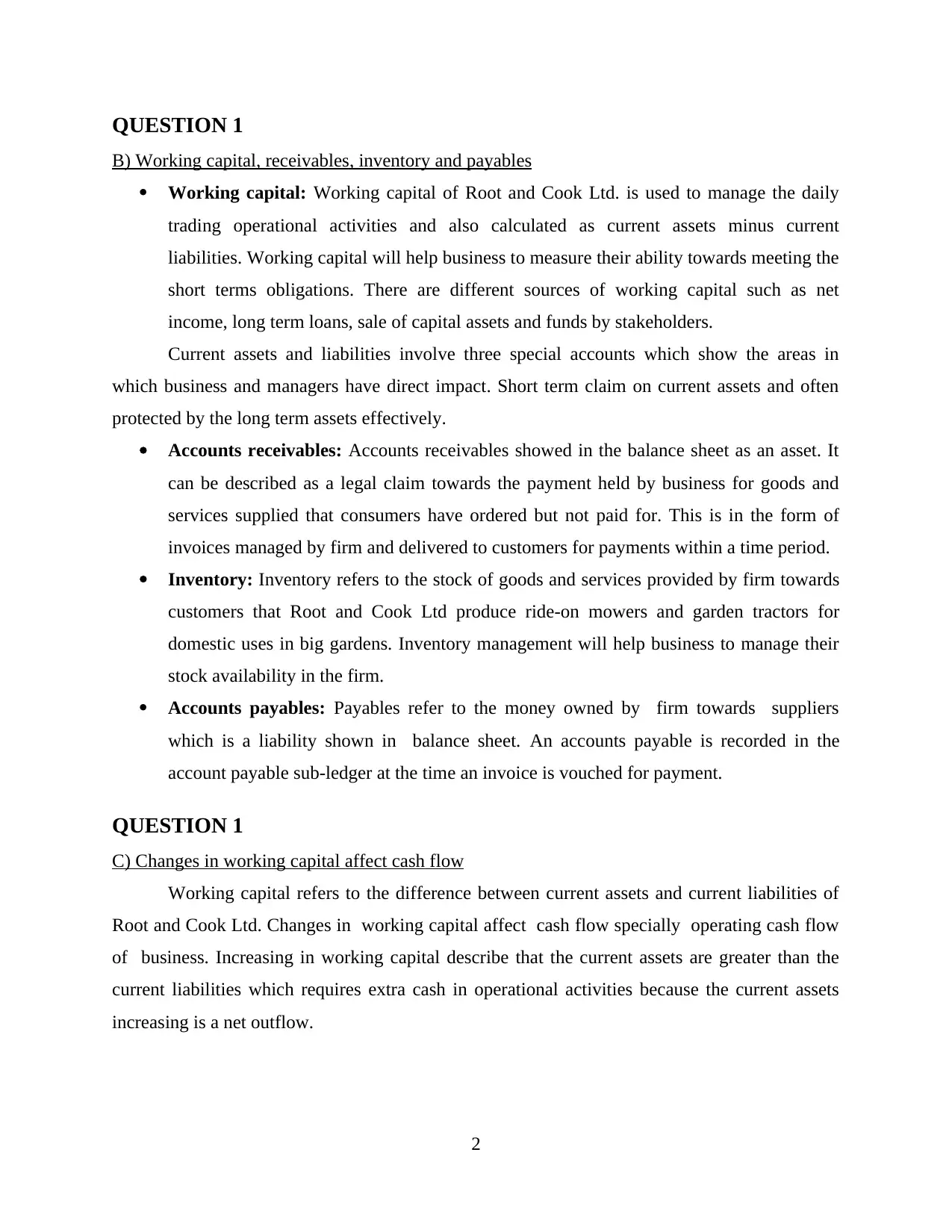
QUESTION 1
B) Working capital, receivables, inventory and payables
Working capital: Working capital of Root and Cook Ltd. is used to manage the daily
trading operational activities and also calculated as current assets minus current
liabilities. Working capital will help business to measure their ability towards meeting the
short terms obligations. There are different sources of working capital such as net
income, long term loans, sale of capital assets and funds by stakeholders.
Current assets and liabilities involve three special accounts which show the areas in
which business and managers have direct impact. Short term claim on current assets and often
protected by the long term assets effectively.
Accounts receivables: Accounts receivables showed in the balance sheet as an asset. It
can be described as a legal claim towards the payment held by business for goods and
services supplied that consumers have ordered but not paid for. This is in the form of
invoices managed by firm and delivered to customers for payments within a time period.
Inventory: Inventory refers to the stock of goods and services provided by firm towards
customers that Root and Cook Ltd produce ride-on mowers and garden tractors for
domestic uses in big gardens. Inventory management will help business to manage their
stock availability in the firm.
Accounts payables: Payables refer to the money owned by firm towards suppliers
which is a liability shown in balance sheet. An accounts payable is recorded in the
account payable sub-ledger at the time an invoice is vouched for payment.
QUESTION 1
C) Changes in working capital affect cash flow
Working capital refers to the difference between current assets and current liabilities of
Root and Cook Ltd. Changes in working capital affect cash flow specially operating cash flow
of business. Increasing in working capital describe that the current assets are greater than the
current liabilities which requires extra cash in operational activities because the current assets
increasing is a net outflow.
2
B) Working capital, receivables, inventory and payables
Working capital: Working capital of Root and Cook Ltd. is used to manage the daily
trading operational activities and also calculated as current assets minus current
liabilities. Working capital will help business to measure their ability towards meeting the
short terms obligations. There are different sources of working capital such as net
income, long term loans, sale of capital assets and funds by stakeholders.
Current assets and liabilities involve three special accounts which show the areas in
which business and managers have direct impact. Short term claim on current assets and often
protected by the long term assets effectively.
Accounts receivables: Accounts receivables showed in the balance sheet as an asset. It
can be described as a legal claim towards the payment held by business for goods and
services supplied that consumers have ordered but not paid for. This is in the form of
invoices managed by firm and delivered to customers for payments within a time period.
Inventory: Inventory refers to the stock of goods and services provided by firm towards
customers that Root and Cook Ltd produce ride-on mowers and garden tractors for
domestic uses in big gardens. Inventory management will help business to manage their
stock availability in the firm.
Accounts payables: Payables refer to the money owned by firm towards suppliers
which is a liability shown in balance sheet. An accounts payable is recorded in the
account payable sub-ledger at the time an invoice is vouched for payment.
QUESTION 1
C) Changes in working capital affect cash flow
Working capital refers to the difference between current assets and current liabilities of
Root and Cook Ltd. Changes in working capital affect cash flow specially operating cash flow
of business. Increasing in working capital describe that the current assets are greater than the
current liabilities which requires extra cash in operational activities because the current assets
increasing is a net outflow.
2
Paraphrase This Document
Need a fresh take? Get an instant paraphrase of this document with our AI Paraphraser
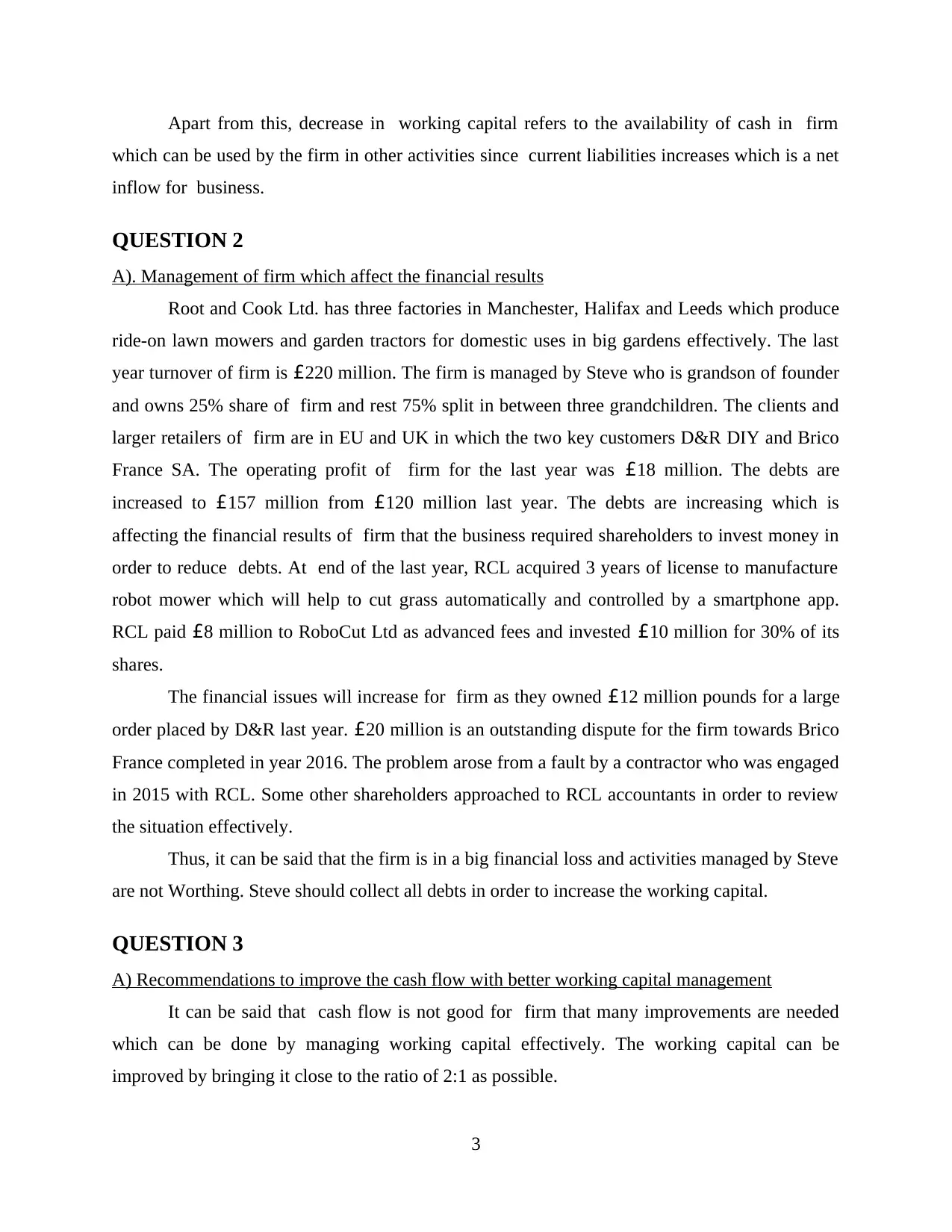
Apart from this, decrease in working capital refers to the availability of cash in firm
which can be used by the firm in other activities since current liabilities increases which is a net
inflow for business.
QUESTION 2
A). Management of firm which affect the financial results
Root and Cook Ltd. has three factories in Manchester, Halifax and Leeds which produce
ride-on lawn mowers and garden tractors for domestic uses in big gardens effectively. The last
year turnover of firm is £220 million. The firm is managed by Steve who is grandson of founder
and owns 25% share of firm and rest 75% split in between three grandchildren. The clients and
larger retailers of firm are in EU and UK in which the two key customers D&R DIY and Brico
France SA. The operating profit of firm for the last year was £18 million. The debts are
increased to £157 million from £120 million last year. The debts are increasing which is
affecting the financial results of firm that the business required shareholders to invest money in
order to reduce debts. At end of the last year, RCL acquired 3 years of license to manufacture
robot mower which will help to cut grass automatically and controlled by a smartphone app.
RCL paid £8 million to RoboCut Ltd as advanced fees and invested £10 million for 30% of its
shares.
The financial issues will increase for firm as they owned £12 million pounds for a large
order placed by D&R last year. £20 million is an outstanding dispute for the firm towards Brico
France completed in year 2016. The problem arose from a fault by a contractor who was engaged
in 2015 with RCL. Some other shareholders approached to RCL accountants in order to review
the situation effectively.
Thus, it can be said that the firm is in a big financial loss and activities managed by Steve
are not Worthing. Steve should collect all debts in order to increase the working capital.
QUESTION 3
A) Recommendations to improve the cash flow with better working capital management
It can be said that cash flow is not good for firm that many improvements are needed
which can be done by managing working capital effectively. The working capital can be
improved by bringing it close to the ratio of 2:1 as possible.
3
which can be used by the firm in other activities since current liabilities increases which is a net
inflow for business.
QUESTION 2
A). Management of firm which affect the financial results
Root and Cook Ltd. has three factories in Manchester, Halifax and Leeds which produce
ride-on lawn mowers and garden tractors for domestic uses in big gardens effectively. The last
year turnover of firm is £220 million. The firm is managed by Steve who is grandson of founder
and owns 25% share of firm and rest 75% split in between three grandchildren. The clients and
larger retailers of firm are in EU and UK in which the two key customers D&R DIY and Brico
France SA. The operating profit of firm for the last year was £18 million. The debts are
increased to £157 million from £120 million last year. The debts are increasing which is
affecting the financial results of firm that the business required shareholders to invest money in
order to reduce debts. At end of the last year, RCL acquired 3 years of license to manufacture
robot mower which will help to cut grass automatically and controlled by a smartphone app.
RCL paid £8 million to RoboCut Ltd as advanced fees and invested £10 million for 30% of its
shares.
The financial issues will increase for firm as they owned £12 million pounds for a large
order placed by D&R last year. £20 million is an outstanding dispute for the firm towards Brico
France completed in year 2016. The problem arose from a fault by a contractor who was engaged
in 2015 with RCL. Some other shareholders approached to RCL accountants in order to review
the situation effectively.
Thus, it can be said that the firm is in a big financial loss and activities managed by Steve
are not Worthing. Steve should collect all debts in order to increase the working capital.
QUESTION 3
A) Recommendations to improve the cash flow with better working capital management
It can be said that cash flow is not good for firm that many improvements are needed
which can be done by managing working capital effectively. The working capital can be
improved by bringing it close to the ratio of 2:1 as possible.
3
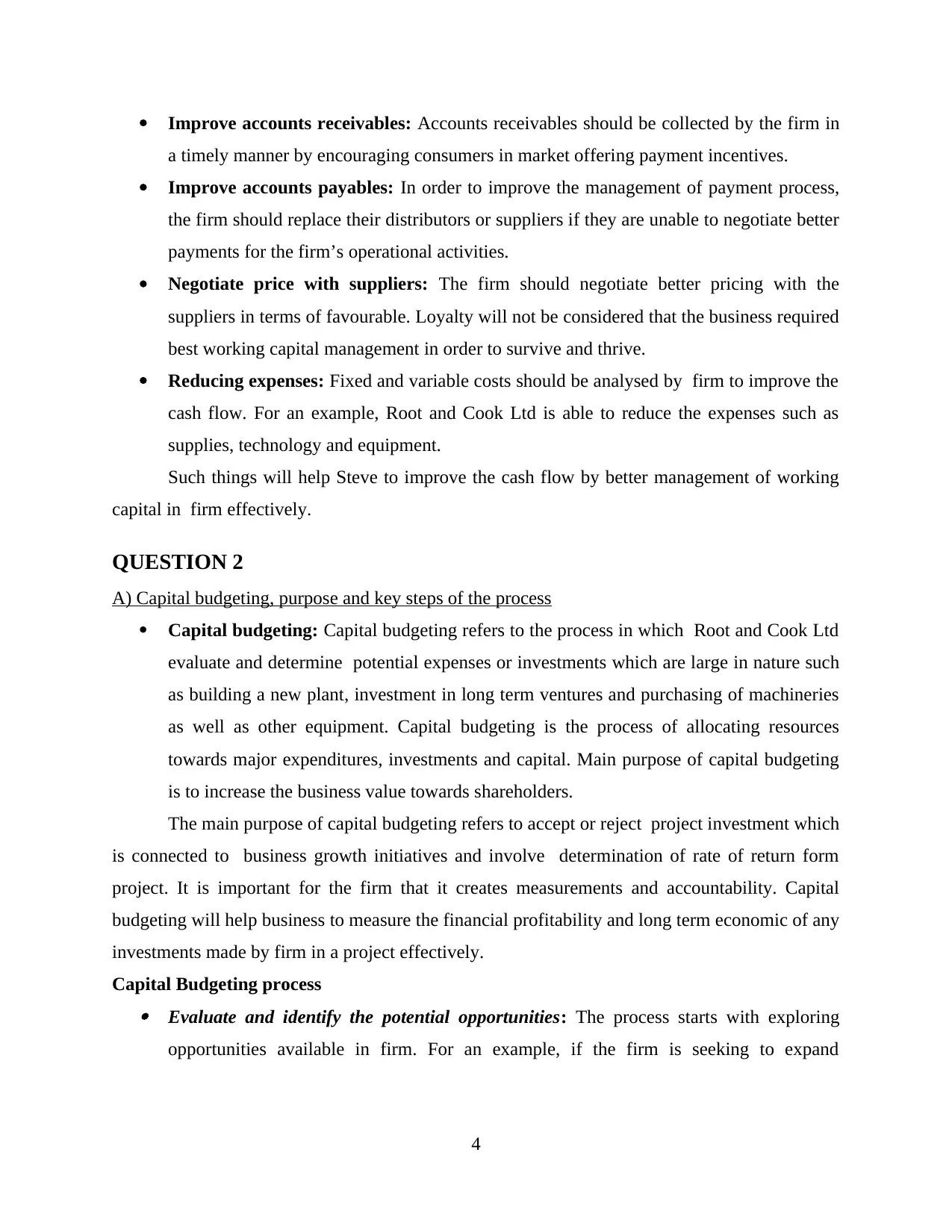
Improve accounts receivables: Accounts receivables should be collected by the firm in
a timely manner by encouraging consumers in market offering payment incentives.
Improve accounts payables: In order to improve the management of payment process,
the firm should replace their distributors or suppliers if they are unable to negotiate better
payments for the firm’s operational activities.
Negotiate price with suppliers: The firm should negotiate better pricing with the
suppliers in terms of favourable. Loyalty will not be considered that the business required
best working capital management in order to survive and thrive.
Reducing expenses: Fixed and variable costs should be analysed by firm to improve the
cash flow. For an example, Root and Cook Ltd is able to reduce the expenses such as
supplies, technology and equipment.
Such things will help Steve to improve the cash flow by better management of working
capital in firm effectively.
QUESTION 2
A) Capital budgeting, purpose and key steps of the process
Capital budgeting: Capital budgeting refers to the process in which Root and Cook Ltd
evaluate and determine potential expenses or investments which are large in nature such
as building a new plant, investment in long term ventures and purchasing of machineries
as well as other equipment. Capital budgeting is the process of allocating resources
towards major expenditures, investments and capital. Main purpose of capital budgeting
is to increase the business value towards shareholders.
The main purpose of capital budgeting refers to accept or reject project investment which
is connected to business growth initiatives and involve determination of rate of return form
project. It is important for the firm that it creates measurements and accountability. Capital
budgeting will help business to measure the financial profitability and long term economic of any
investments made by firm in a project effectively.
Capital Budgeting process Evaluate and identify the potential opportunities: The process starts with exploring
opportunities available in firm. For an example, if the firm is seeking to expand
4
a timely manner by encouraging consumers in market offering payment incentives.
Improve accounts payables: In order to improve the management of payment process,
the firm should replace their distributors or suppliers if they are unable to negotiate better
payments for the firm’s operational activities.
Negotiate price with suppliers: The firm should negotiate better pricing with the
suppliers in terms of favourable. Loyalty will not be considered that the business required
best working capital management in order to survive and thrive.
Reducing expenses: Fixed and variable costs should be analysed by firm to improve the
cash flow. For an example, Root and Cook Ltd is able to reduce the expenses such as
supplies, technology and equipment.
Such things will help Steve to improve the cash flow by better management of working
capital in firm effectively.
QUESTION 2
A) Capital budgeting, purpose and key steps of the process
Capital budgeting: Capital budgeting refers to the process in which Root and Cook Ltd
evaluate and determine potential expenses or investments which are large in nature such
as building a new plant, investment in long term ventures and purchasing of machineries
as well as other equipment. Capital budgeting is the process of allocating resources
towards major expenditures, investments and capital. Main purpose of capital budgeting
is to increase the business value towards shareholders.
The main purpose of capital budgeting refers to accept or reject project investment which
is connected to business growth initiatives and involve determination of rate of return form
project. It is important for the firm that it creates measurements and accountability. Capital
budgeting will help business to measure the financial profitability and long term economic of any
investments made by firm in a project effectively.
Capital Budgeting process Evaluate and identify the potential opportunities: The process starts with exploring
opportunities available in firm. For an example, if the firm is seeking to expand
4
⊘ This is a preview!⊘
Do you want full access?
Subscribe today to unlock all pages.

Trusted by 1+ million students worldwide
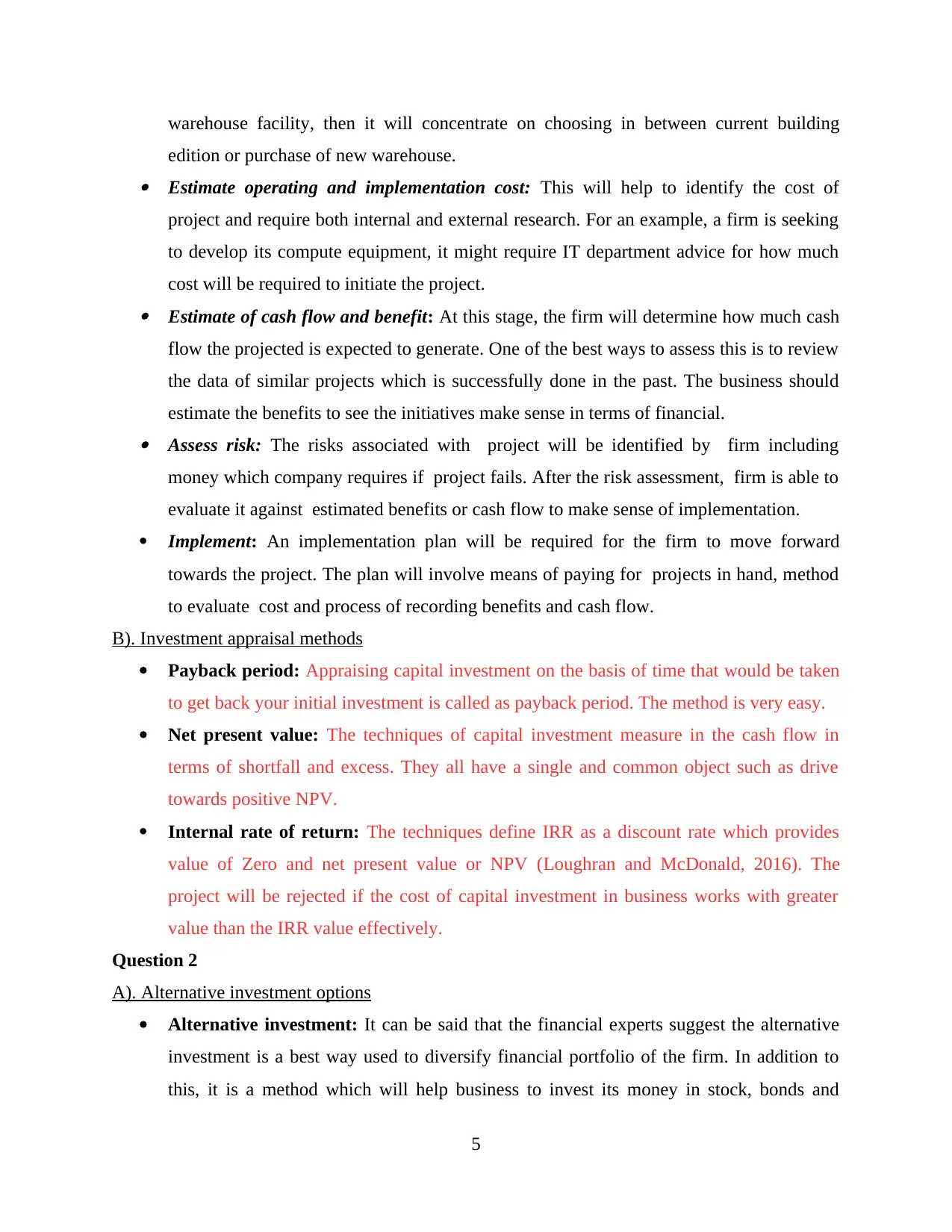
warehouse facility, then it will concentrate on choosing in between current building
edition or purchase of new warehouse. Estimate operating and implementation cost: This will help to identify the cost of
project and require both internal and external research. For an example, a firm is seeking
to develop its compute equipment, it might require IT department advice for how much
cost will be required to initiate the project. Estimate of cash flow and benefit: At this stage, the firm will determine how much cash
flow the projected is expected to generate. One of the best ways to assess this is to review
the data of similar projects which is successfully done in the past. The business should
estimate the benefits to see the initiatives make sense in terms of financial. Assess risk: The risks associated with project will be identified by firm including
money which company requires if project fails. After the risk assessment, firm is able to
evaluate it against estimated benefits or cash flow to make sense of implementation.
Implement: An implementation plan will be required for the firm to move forward
towards the project. The plan will involve means of paying for projects in hand, method
to evaluate cost and process of recording benefits and cash flow.
B). Investment appraisal methods
Payback period: Appraising capital investment on the basis of time that would be taken
to get back your initial investment is called as payback period. The method is very easy.
Net present value: The techniques of capital investment measure in the cash flow in
terms of shortfall and excess. They all have a single and common object such as drive
towards positive NPV.
Internal rate of return: The techniques define IRR as a discount rate which provides
value of Zero and net present value or NPV (Loughran and McDonald, 2016). The
project will be rejected if the cost of capital investment in business works with greater
value than the IRR value effectively.
Question 2
A). Alternative investment options
Alternative investment: It can be said that the financial experts suggest the alternative
investment is a best way used to diversify financial portfolio of the firm. In addition to
this, it is a method which will help business to invest its money in stock, bonds and
5
edition or purchase of new warehouse. Estimate operating and implementation cost: This will help to identify the cost of
project and require both internal and external research. For an example, a firm is seeking
to develop its compute equipment, it might require IT department advice for how much
cost will be required to initiate the project. Estimate of cash flow and benefit: At this stage, the firm will determine how much cash
flow the projected is expected to generate. One of the best ways to assess this is to review
the data of similar projects which is successfully done in the past. The business should
estimate the benefits to see the initiatives make sense in terms of financial. Assess risk: The risks associated with project will be identified by firm including
money which company requires if project fails. After the risk assessment, firm is able to
evaluate it against estimated benefits or cash flow to make sense of implementation.
Implement: An implementation plan will be required for the firm to move forward
towards the project. The plan will involve means of paying for projects in hand, method
to evaluate cost and process of recording benefits and cash flow.
B). Investment appraisal methods
Payback period: Appraising capital investment on the basis of time that would be taken
to get back your initial investment is called as payback period. The method is very easy.
Net present value: The techniques of capital investment measure in the cash flow in
terms of shortfall and excess. They all have a single and common object such as drive
towards positive NPV.
Internal rate of return: The techniques define IRR as a discount rate which provides
value of Zero and net present value or NPV (Loughran and McDonald, 2016). The
project will be rejected if the cost of capital investment in business works with greater
value than the IRR value effectively.
Question 2
A). Alternative investment options
Alternative investment: It can be said that the financial experts suggest the alternative
investment is a best way used to diversify financial portfolio of the firm. In addition to
this, it is a method which will help business to invest its money in stock, bonds and
5
Paraphrase This Document
Need a fresh take? Get an instant paraphrase of this document with our AI Paraphraser
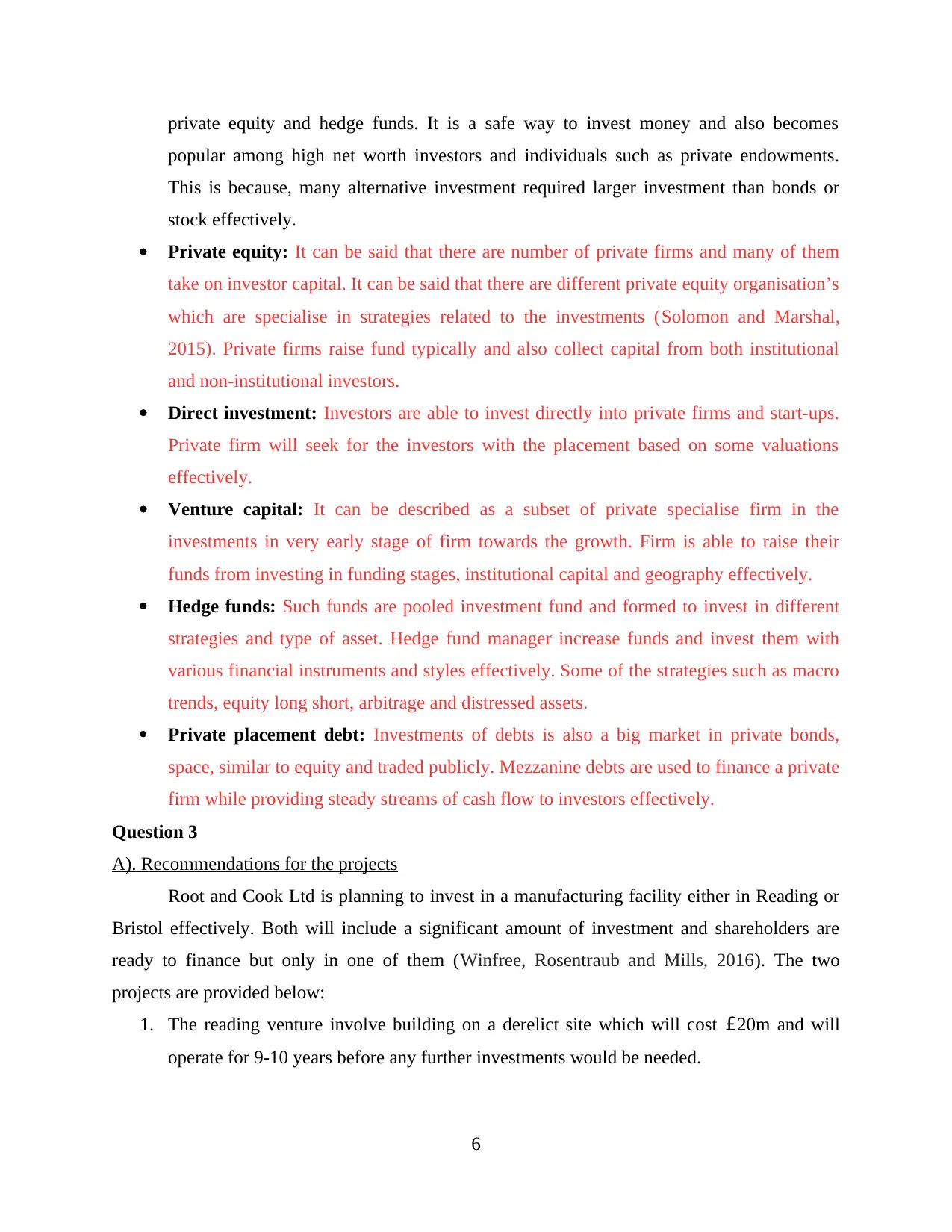
private equity and hedge funds. It is a safe way to invest money and also becomes
popular among high net worth investors and individuals such as private endowments.
This is because, many alternative investment required larger investment than bonds or
stock effectively.
Private equity: It can be said that there are number of private firms and many of them
take on investor capital. It can be said that there are different private equity organisation’s
which are specialise in strategies related to the investments (Solomon and Marshal,
2015). Private firms raise fund typically and also collect capital from both institutional
and non-institutional investors.
Direct investment: Investors are able to invest directly into private firms and start-ups.
Private firm will seek for the investors with the placement based on some valuations
effectively.
Venture capital: It can be described as a subset of private specialise firm in the
investments in very early stage of firm towards the growth. Firm is able to raise their
funds from investing in funding stages, institutional capital and geography effectively.
Hedge funds: Such funds are pooled investment fund and formed to invest in different
strategies and type of asset. Hedge fund manager increase funds and invest them with
various financial instruments and styles effectively. Some of the strategies such as macro
trends, equity long short, arbitrage and distressed assets.
Private placement debt: Investments of debts is also a big market in private bonds,
space, similar to equity and traded publicly. Mezzanine debts are used to finance a private
firm while providing steady streams of cash flow to investors effectively.
Question 3
A). Recommendations for the projects
Root and Cook Ltd is planning to invest in a manufacturing facility either in Reading or
Bristol effectively. Both will include a significant amount of investment and shareholders are
ready to finance but only in one of them (Winfree, Rosentraub and Mills, 2016). The two
projects are provided below:
1. The reading venture involve building on a derelict site which will cost £20m and will
operate for 9-10 years before any further investments would be needed.
6
popular among high net worth investors and individuals such as private endowments.
This is because, many alternative investment required larger investment than bonds or
stock effectively.
Private equity: It can be said that there are number of private firms and many of them
take on investor capital. It can be said that there are different private equity organisation’s
which are specialise in strategies related to the investments (Solomon and Marshal,
2015). Private firms raise fund typically and also collect capital from both institutional
and non-institutional investors.
Direct investment: Investors are able to invest directly into private firms and start-ups.
Private firm will seek for the investors with the placement based on some valuations
effectively.
Venture capital: It can be described as a subset of private specialise firm in the
investments in very early stage of firm towards the growth. Firm is able to raise their
funds from investing in funding stages, institutional capital and geography effectively.
Hedge funds: Such funds are pooled investment fund and formed to invest in different
strategies and type of asset. Hedge fund manager increase funds and invest them with
various financial instruments and styles effectively. Some of the strategies such as macro
trends, equity long short, arbitrage and distressed assets.
Private placement debt: Investments of debts is also a big market in private bonds,
space, similar to equity and traded publicly. Mezzanine debts are used to finance a private
firm while providing steady streams of cash flow to investors effectively.
Question 3
A). Recommendations for the projects
Root and Cook Ltd is planning to invest in a manufacturing facility either in Reading or
Bristol effectively. Both will include a significant amount of investment and shareholders are
ready to finance but only in one of them (Winfree, Rosentraub and Mills, 2016). The two
projects are provided below:
1. The reading venture involve building on a derelict site which will cost £20m and will
operate for 9-10 years before any further investments would be needed.
6
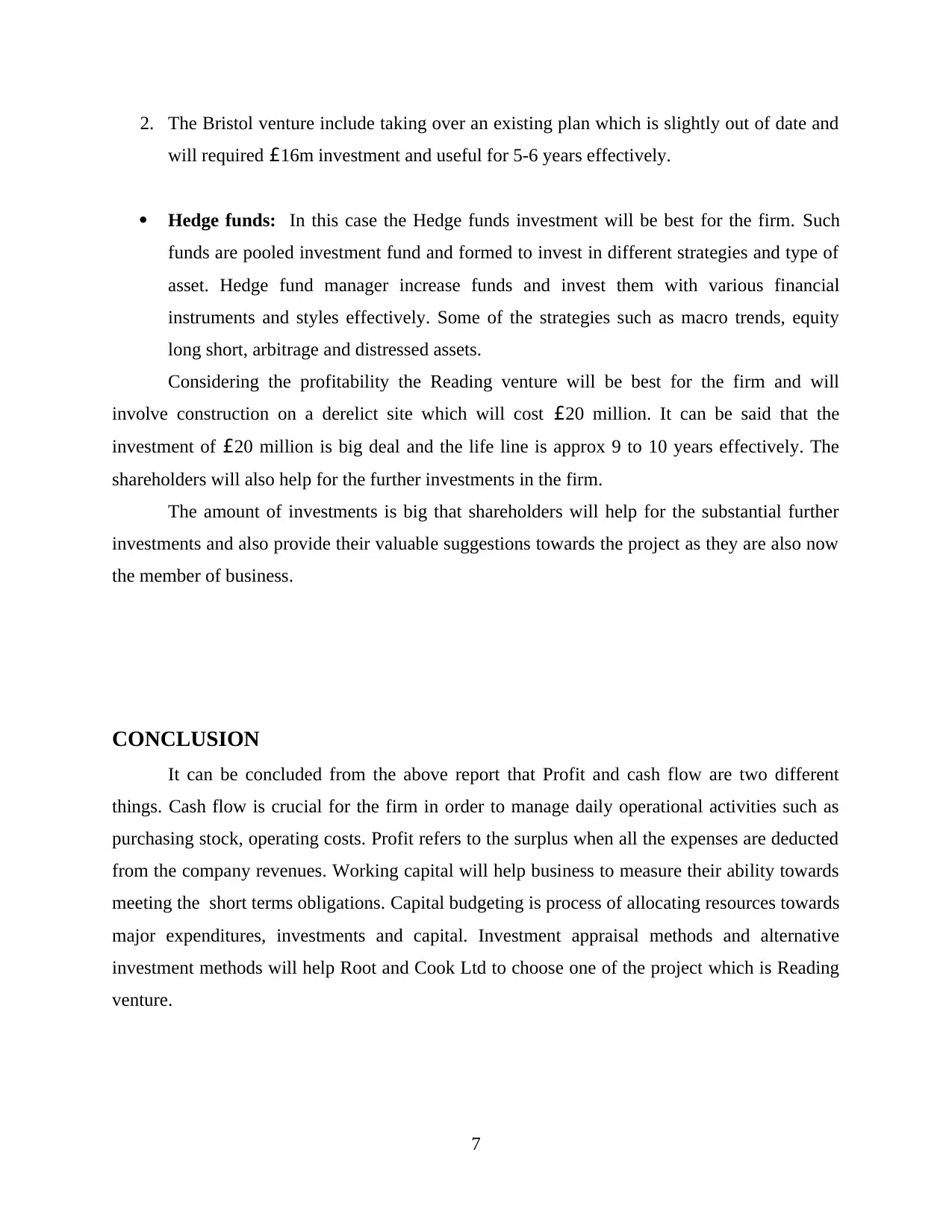
2. The Bristol venture include taking over an existing plan which is slightly out of date and
will required £16m investment and useful for 5-6 years effectively.
Hedge funds: In this case the Hedge funds investment will be best for the firm. Such
funds are pooled investment fund and formed to invest in different strategies and type of
asset. Hedge fund manager increase funds and invest them with various financial
instruments and styles effectively. Some of the strategies such as macro trends, equity
long short, arbitrage and distressed assets.
Considering the profitability the Reading venture will be best for the firm and will
involve construction on a derelict site which will cost £20 million. It can be said that the
investment of £20 million is big deal and the life line is approx 9 to 10 years effectively. The
shareholders will also help for the further investments in the firm.
The amount of investments is big that shareholders will help for the substantial further
investments and also provide their valuable suggestions towards the project as they are also now
the member of business.
CONCLUSION
It can be concluded from the above report that Profit and cash flow are two different
things. Cash flow is crucial for the firm in order to manage daily operational activities such as
purchasing stock, operating costs. Profit refers to the surplus when all the expenses are deducted
from the company revenues. Working capital will help business to measure their ability towards
meeting the short terms obligations. Capital budgeting is process of allocating resources towards
major expenditures, investments and capital. Investment appraisal methods and alternative
investment methods will help Root and Cook Ltd to choose one of the project which is Reading
venture.
7
will required £16m investment and useful for 5-6 years effectively.
Hedge funds: In this case the Hedge funds investment will be best for the firm. Such
funds are pooled investment fund and formed to invest in different strategies and type of
asset. Hedge fund manager increase funds and invest them with various financial
instruments and styles effectively. Some of the strategies such as macro trends, equity
long short, arbitrage and distressed assets.
Considering the profitability the Reading venture will be best for the firm and will
involve construction on a derelict site which will cost £20 million. It can be said that the
investment of £20 million is big deal and the life line is approx 9 to 10 years effectively. The
shareholders will also help for the further investments in the firm.
The amount of investments is big that shareholders will help for the substantial further
investments and also provide their valuable suggestions towards the project as they are also now
the member of business.
CONCLUSION
It can be concluded from the above report that Profit and cash flow are two different
things. Cash flow is crucial for the firm in order to manage daily operational activities such as
purchasing stock, operating costs. Profit refers to the surplus when all the expenses are deducted
from the company revenues. Working capital will help business to measure their ability towards
meeting the short terms obligations. Capital budgeting is process of allocating resources towards
major expenditures, investments and capital. Investment appraisal methods and alternative
investment methods will help Root and Cook Ltd to choose one of the project which is Reading
venture.
7
⊘ This is a preview!⊘
Do you want full access?
Subscribe today to unlock all pages.

Trusted by 1+ million students worldwide
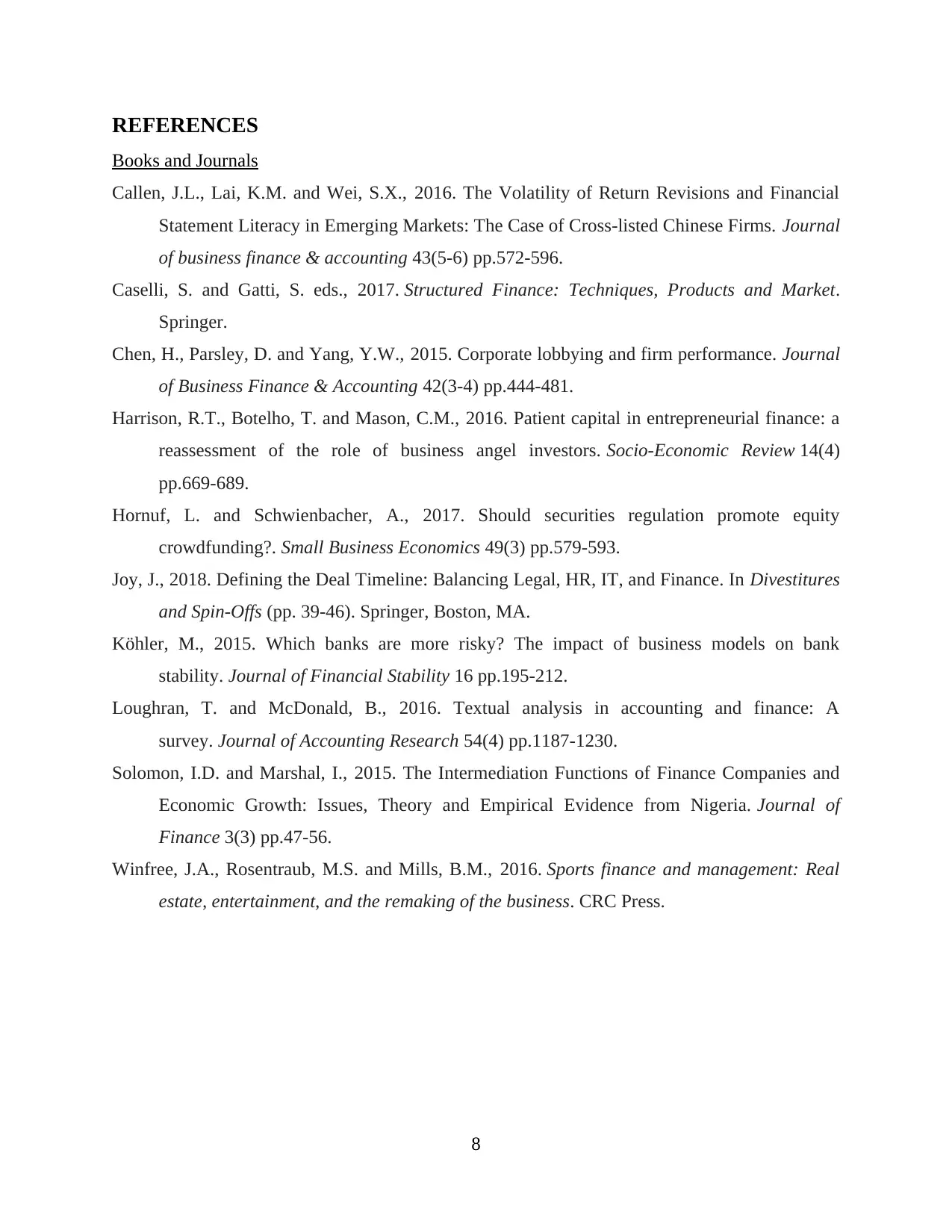
REFERENCES
Books and Journals
Callen, J.L., Lai, K.M. and Wei, S.X., 2016. The Volatility of Return Revisions and Financial
Statement Literacy in Emerging Markets: The Case of Cross‐listed Chinese Firms. Journal
of business finance & accounting 43(5-6) pp.572-596.
Caselli, S. and Gatti, S. eds., 2017. Structured Finance: Techniques, Products and Market.
Springer.
Chen, H., Parsley, D. and Yang, Y.W., 2015. Corporate lobbying and firm performance. Journal
of Business Finance & Accounting 42(3-4) pp.444-481.
Harrison, R.T., Botelho, T. and Mason, C.M., 2016. Patient capital in entrepreneurial finance: a
reassessment of the role of business angel investors. Socio-Economic Review 14(4)
pp.669-689.
Hornuf, L. and Schwienbacher, A., 2017. Should securities regulation promote equity
crowdfunding?. Small Business Economics 49(3) pp.579-593.
Joy, J., 2018. Defining the Deal Timeline: Balancing Legal, HR, IT, and Finance. In Divestitures
and Spin-Offs (pp. 39-46). Springer, Boston, MA.
Köhler, M., 2015. Which banks are more risky? The impact of business models on bank
stability. Journal of Financial Stability 16 pp.195-212.
Loughran, T. and McDonald, B., 2016. Textual analysis in accounting and finance: A
survey. Journal of Accounting Research 54(4) pp.1187-1230.
Solomon, I.D. and Marshal, I., 2015. The Intermediation Functions of Finance Companies and
Economic Growth: Issues, Theory and Empirical Evidence from Nigeria. Journal of
Finance 3(3) pp.47-56.
Winfree, J.A., Rosentraub, M.S. and Mills, B.M., 2016. Sports finance and management: Real
estate, entertainment, and the remaking of the business. CRC Press.
8
Books and Journals
Callen, J.L., Lai, K.M. and Wei, S.X., 2016. The Volatility of Return Revisions and Financial
Statement Literacy in Emerging Markets: The Case of Cross‐listed Chinese Firms. Journal
of business finance & accounting 43(5-6) pp.572-596.
Caselli, S. and Gatti, S. eds., 2017. Structured Finance: Techniques, Products and Market.
Springer.
Chen, H., Parsley, D. and Yang, Y.W., 2015. Corporate lobbying and firm performance. Journal
of Business Finance & Accounting 42(3-4) pp.444-481.
Harrison, R.T., Botelho, T. and Mason, C.M., 2016. Patient capital in entrepreneurial finance: a
reassessment of the role of business angel investors. Socio-Economic Review 14(4)
pp.669-689.
Hornuf, L. and Schwienbacher, A., 2017. Should securities regulation promote equity
crowdfunding?. Small Business Economics 49(3) pp.579-593.
Joy, J., 2018. Defining the Deal Timeline: Balancing Legal, HR, IT, and Finance. In Divestitures
and Spin-Offs (pp. 39-46). Springer, Boston, MA.
Köhler, M., 2015. Which banks are more risky? The impact of business models on bank
stability. Journal of Financial Stability 16 pp.195-212.
Loughran, T. and McDonald, B., 2016. Textual analysis in accounting and finance: A
survey. Journal of Accounting Research 54(4) pp.1187-1230.
Solomon, I.D. and Marshal, I., 2015. The Intermediation Functions of Finance Companies and
Economic Growth: Issues, Theory and Empirical Evidence from Nigeria. Journal of
Finance 3(3) pp.47-56.
Winfree, J.A., Rosentraub, M.S. and Mills, B.M., 2016. Sports finance and management: Real
estate, entertainment, and the remaking of the business. CRC Press.
8
1 out of 10
Related Documents
Your All-in-One AI-Powered Toolkit for Academic Success.
+13062052269
info@desklib.com
Available 24*7 on WhatsApp / Email
![[object Object]](/_next/static/media/star-bottom.7253800d.svg)
Unlock your academic potential
Copyright © 2020–2025 A2Z Services. All Rights Reserved. Developed and managed by ZUCOL.





